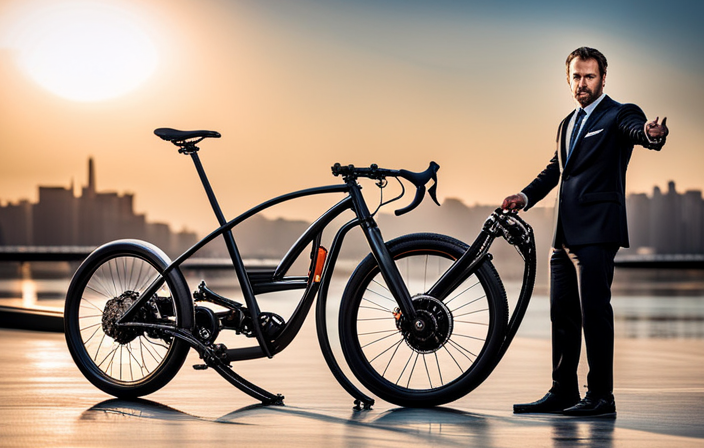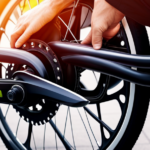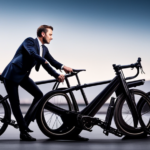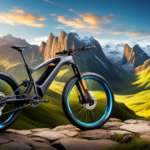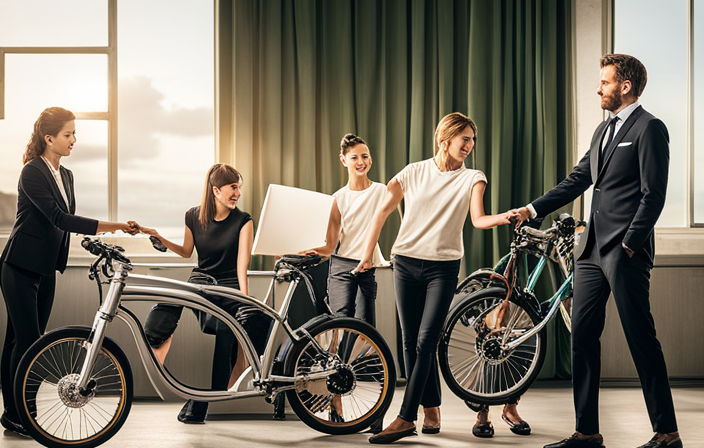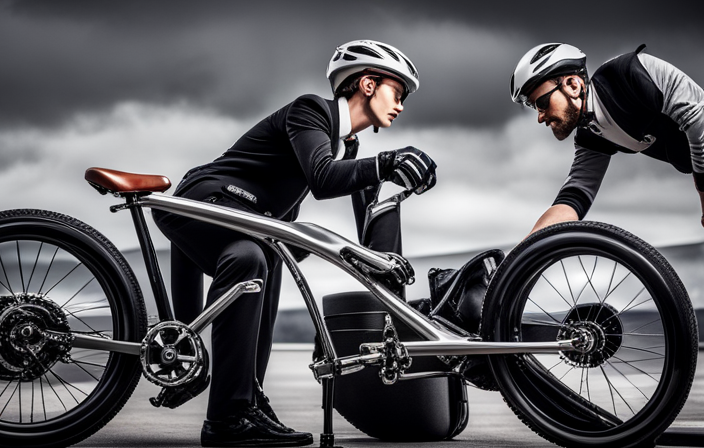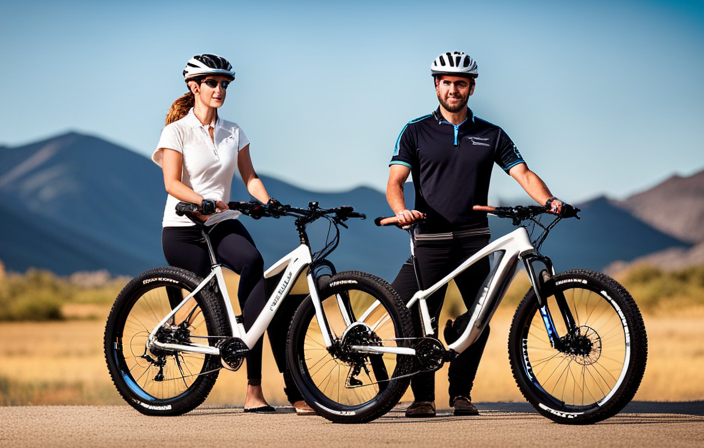Did you know that electric bikes are becoming increasingly popular, with sales projected to reach 40 million units by 2025?
If you want to join the growing community of electric bike riders, this article will guide you through the process of converting your ordinary bike into an electric one.
From assessing your bike’s compatibility to installing the conversion kit and learning how to ride your new electric bike, we will provide you with the technical, precise, and detailed information you need to successfully make the switch.
Key Takeaways
- Assess bike compatibility and evaluate components for weight and power handling
- Choose the right conversion kit based on riding needs, style, power output, and battery capacity
- Consider additional accessories and features like extended range battery packs, comfortable saddles, lights, fenders, and cargo racks
- Understand the installation process, including gathering tools, preparing the bike, installing the conversion kit, adjusting and fine-tuning, and troubleshooting.
Assess Your Bike’s Compatibility
You’ll need to assess if your bike is compatible for conversion to an electric bike. Start by evaluating the components of your bike to determine if they can handle the additional weight and power of an electric motor. Check the frame for any signs of damage or weakness, as it will need to support the motor and battery.
Look at the fork and rear dropouts to ensure they can accommodate the necessary attachments. Examine the brakes and determine if they are strong enough to handle the increased speed. Assess the drivetrain and make sure it is in good condition, as it will need to handle the torque from the motor. Finally, check the wheel size and tire clearance to ensure they are compatible with the electric conversion kit.
Once you have assessed compatibility, you can move on to choosing the right electric bike conversion kit.
Choose the Right Electric Bike Conversion Kit
When choosing the right electric bike conversion kit, you need to consider your riding needs and style.
Determine the type of motor and battery that will best suit your requirements.
Additionally, make sure to select the appropriate conversion kit size to ensure a seamless and efficient conversion process.
Consider Your Riding Needs and Style
If you’re considering converting your bike to an electric bike, think about your riding needs and style. It’s important to choose a conversion kit that aligns with your riding techniques and preferences. Whether you enjoy long-distance rides or need extra power for uphill climbs, understanding your riding style will help you select the right components. Additionally, consider the accessories you might need, such as a throttle, pedal-assist sensor, or display panel. These accessories can enhance your riding experience and provide convenience. To help you make an informed decision, here’s a table summarizing the different riding needs and the corresponding accessories you should consider:
| Riding Needs | Accessories to Consider |
|---|---|
| Long-distance rides | Extended range battery pack, comfortable saddle |
| Uphill climbs | High torque motor, larger chainring |
| City commuting | Integrated lights, fenders, cargo rack |
By considering your riding needs and style, you can determine the type of motor and battery that will best suit your requirements. Transitioning into the next section, let’s explore how to determine the type of motor and battery for your electric bike conversion.
Determine the Type of Motor and Battery
To determine the type of motor and battery for your e-bike conversion, consider your riding needs and style. Choosing the right components is crucial to ensure optimal performance and efficiency. Here are four key factors to consider:
-
Power Output: Understanding the power output of the motor is important as it directly affects the speed and torque of your e-bike. Consider the terrain you’ll be riding on and the level of assistance you require.
-
Motor Type: There are various motor types available, such as hub motors and mid-drive motors. Hub motors are simpler to install and maintain, while mid-drive motors provide better balance and efficiency.
-
Battery Capacity: The battery capacity determines the range of your e-bike. Consider the distance you’ll be traveling and choose a battery with sufficient capacity to meet your needs.
-
Battery Type: Different battery chemistries, such as lithium-ion and lead-acid, offer varying levels of performance, weight, and lifespan. Select the appropriate battery type based on your preferences and budget.
Now that you have determined the type of motor and battery, it’s time to select the appropriate conversion kit size for your e-bike.
Select the Appropriate Conversion Kit Size
Choosing the right conversion kit size is crucial for a successful e-bike conversion. It is important to consider the power and range capabilities of the motor, battery, and controller when making your selection. To help you make an informed decision, let’s take a look at the following table:
| Conversion Kit Size | Motor Power (Watts) | Battery Capacity (Ah) | Range (Miles) |
|---|---|---|---|
| Small | 250-500 | 8-10 | 15-20 |
| Medium | 500-750 | 10-12 | 20-30 |
| Large | 750-1000 | 12-15 | 30-40 |
By understanding the power and range capabilities of each conversion kit size, you can select the one that best suits your needs. Once you have chosen the appropriate conversion kit size, you can move on to the next step of gathering the necessary tools and equipment. This will ensure a smooth and efficient conversion process.
Gather the Necessary Tools and Equipment
First, make sure you have all the tools and equipment you’ll need to convert your bike to an electric bike. Assessing compatibility and choosing the right kit are crucial steps in this process.
To begin, gather a set of wrenches, pliers, wire cutters, and a multimeter for electrical testing. You’ll also need a torque wrench to properly tighten the components. Additionally, you’ll require a drill with various bits, as well as a soldering iron and heat shrink tubing for electrical connections. Don’t forget to have a set of Allen keys and a tire pump on hand.
These tools will enable you to disassemble your bike, install the electric conversion kit, and make any necessary adjustments.
With all the necessary tools at your disposal, you can now move on to preparing your bike for conversion by following the next section’s instructions.
Prepare Your Bike for Conversion
Now that you have gathered all the necessary tools and equipment, it’s time to prepare your bike for conversion.
The first step is to assess the compatibility of your bike with an electric conversion. Take a close look at your bike’s frame, forks, and wheels to ensure that they can handle the additional weight and stress of an electric motor.
Once you have determined that your bike is compatible, it’s time to choose a conversion kit. There are various options available, so consider factors such as your budget, desired level of power, and the type of riding you will be doing.
Whether you opt for a front-wheel, rear-wheel, or mid-drive conversion kit, make sure to carefully follow the manufacturer’s instructions.
With your bike assessed and a conversion kit chosen, you are now ready to move on to the next step: installing the electric bike conversion kit.
Install the Electric Bike Conversion Kit
To install the electric bike conversion kit, you’ll need to carefully follow the manufacturer’s instructions and ensure that all components are securely attached. Here’s a step-by-step guide:
-
Begin by removing the front wheel of your bike and replacing it with the electric hub motor wheel included in the kit. Make sure to tighten the axle nuts properly.
-
Mount the battery pack securely onto the frame of your bike using the provided brackets. Ensure that it is well-balanced and won’t interfere with your pedaling.
-
Connect the motor controller to the hub motor and the battery pack, following the wiring diagram provided in the instructions. Use zip ties to neatly secure the wires along the frame.
Once you have completed the installation of the electric bike conversion kit, you can move on to the next step: adjusting and fine-tuning your electric bike.
Adjust and Fine-Tune Your Electric Bike
Make sure you carefully adjust and fine-tune your newly converted electric bike for optimal performance. Fine-tuning is crucial to ensure that your electric bike operates smoothly and efficiently.
Start by adjusting the brakes to ensure they engage properly and provide adequate stopping power. Check the tire pressure and make any necessary adjustments to ensure a smooth ride. Additionally, take the time to adjust the gears and chain tension to optimize performance.
If you encounter any issues during the fine-tuning process, troubleshoot them by checking the wiring connections, motor alignment, and battery placement. By fine-tuning your electric bike, you can maximize its performance and address any potential issues.
Once you have completed this step, you will be ready to learn how to ride your new electric bike smoothly and confidently.
Learn How to Ride Your New Electric Bike
To effectively ride your new electric bike, it’s crucial to understand the different power modes available.
Familiarize yourself with the power levels, such as eco or turbo, and learn how to switch between them to optimize your riding experience.
Additionally, practice starting and stopping smoothly to ensure a safe and controlled ride.
Lastly, become familiar with the electric assist system, which provides additional power while pedaling, and learn how to utilize it effectively to enhance your overall biking performance.
Understand the Different Power Modes
Understanding the different power modes is crucial when converting your bike to an electric bike. There are generally three power modes available: low, medium, and high. Each mode has its pros and cons.
In low mode, you can conserve battery power and increase your bike’s range, but the speed and acceleration may be limited.
Medium mode offers a good balance between power and efficiency, providing a decent speed while still maintaining a respectable range.
High mode, on the other hand, offers maximum power and speed, but it can consume more battery, reducing the overall range. To maximize efficiency, it is recommended to use low or medium power modes when riding on flat terrain and switch to high mode only when necessary, like when climbing hills.
Understanding and utilizing these power modes will help you get the most out of your electric bike.
Now, let’s move on to the next section and learn how to practice starting and stopping smoothly.
Practice Starting and Stopping
Now, let’s get some practice in by learning how to smoothly start and stop on an e-bike.
Mastering the starting techniques is crucial to ensure a safe and efficient ride. When starting, apply a steady pressure on the pedals while simultaneously engaging the electric assist system. This will provide an initial boost of power, allowing you to accelerate smoothly. It’s important to maintain a balanced posture and distribute your weight evenly between the pedals as you start.
To stop effectively, gently squeeze the brake levers while gradually reducing your pedal pressure. This will engage the regenerative braking system, which converts kinetic energy into electrical energy, extending your battery life.
Practice these starting and stopping techniques until they become second nature. By doing so, you’ll be well-prepared to move on to the next section and get familiar with the electric assist system.
Get Familiar with the Electric Assist System
Before diving into the next step, let’s quickly recap what we learned in the previous subtopic. You practiced starting and stopping on your electric bike, which is crucial for mastering control and safety.
Now, let’s move on to the current subtopic and get familiar with the electric assist system. This system is the heart of your electric bike and understanding it will greatly enhance your riding experience. Here are three key points to remember:
-
Electric assist advantages: The electric assist system provides a boost to your pedaling, making it easier to climb hills, ride longer distances, and overcome challenging terrains.
-
Different types of electric assist systems: There are various types of electric assist systems, including pedal-assist, throttle-assist, and torque-sensing systems. Each has its own unique features and benefits.
-
Transition: Now that you have a basic understanding of the electric assist system, it’s time to delve into how to maintain and care for your electric bike.
Continue reading to learn how to properly maintain and care for your electric bike to ensure its longevity and optimal performance.
Maintain and Care for Your Electric Bike
To maintain and care for your electric bike, it’s crucial to regularly clean and lubricate the chain. This will ensure smooth and efficient operation of the bike.
Additionally, you should regularly check the battery life and charging to ensure that your bike is always ready for use.
Lastly, it’s important to inspect and replace worn components to avoid any potential safety hazards and to maintain optimal performance.
Regularly Clean and Lubricate the Chain
Make sure you regularly clean and lubricate the chain of your bike to keep it running smoothly. The chain is a crucial component that transfers power from the pedals to the wheels, so it requires proper maintenance. Follow this cleaning technique for optimal results:
-
Start by removing any dirt or grime from the chain using a brush or rag.
-
Apply a degreaser to dissolve any stubborn grease or oil buildup.
-
Use a chain cleaning tool or a brush to thoroughly clean the chain, ensuring all the links are free from residue.
To ensure smooth operation, use a suitable lubrication method afterwards. Apply a high-quality bicycle chain lubricant evenly along the chain, allowing it to penetrate the links. Wipe off any excess lubricant to prevent attracting dirt.
Now, let’s move on to the next section about checking the battery life and charging.
Check the Battery Life and Charging
Now that you have properly cleaned and lubricated the chain of your electric bike, it’s important to move on to the next crucial step: checking the battery life and charging.
Battery maintenance is essential for the optimal performance and longevity of your electric bike. Start by inspecting the battery for any signs of damage or wear. Check the battery connections to ensure they are secure and clean.
Next, assess the battery life to determine if it needs to be charged. If the battery is low, connect it to a reliable charging infrastructure. It’s recommended to use a charger specifically designed for electric bikes.
Once the battery is fully charged, you can proceed to the next section about inspecting and replacing worn components. This step ensures the overall safety and efficiency of your electric bike.
Inspect and Replace Worn Components
First, take a close look at all the components of your e-bike to see if any of them are worn and need to be replaced. Inspecting and replacing worn components is crucial for ensuring the optimal performance and safety of your electric bike. Start by examining the brake system, including the brake pads, rotors, and cables. If any of these components show signs of wear, such as thin or uneven brake pads or frayed cables, it is essential to replace them to maintain reliable stopping power. Additionally, consider upgrading the suspension system if you frequently ride on rough terrain or desire a smoother ride. A better suspension can enhance your comfort and control while riding. By replacing worn components and upgrading the suspension, you can maximize the overall performance and safety of your e-bike. Now, let’s move on to the next section about staying safe and following local regulations.
Stay Safe and Follow Local Regulations
When riding your electric bike, it’s crucial to prioritize your safety. This means wearing a helmet and protective gear to provide necessary protection in case of accidents or falls.
Additionally, it’s essential to observe traffic laws and signals. This ensures smooth and safe navigation on the road.
Lastly, it’s important to respect pedestrians and other cyclists. Give them the right of way and maintain a safe distance.
Following these key points will help you stay safe and prevent potential accidents while riding your electric bike.
Wear a Helmet and Protective Gear
Be sure to wear a helmet and protective gear when converting your bike to an electric bike. Safety should always be your top priority.
Here are some important items to consider:
-
Helmet: A properly fitted helmet is essential for protecting your head in case of a fall or collision. Make sure it meets safety standards and covers your forehead.
-
Knee and elbow pads: These protective gear items provide cushioning and prevent injuries to your joints during accidents.
-
Reflective clothing: Wearing reflective clothing makes you more visible to other road users, especially during low-light conditions.
-
Gloves: Gloves not only provide grip but also protect your hands from abrasions in case of a fall.
By wearing the right gear, you minimize the risk of serious injuries.
Now that you understand the importance of protective gear, let’s move on to the next section and discuss how to observe traffic laws and signals effectively.
Observe Traffic Laws and Signals
To ensure safety on the road, it’s important to obey traffic laws and signals. Traffic safety is crucial when converting your bike to an electric bike. As a rider, you must understand and follow the rules of the road.
Always stop at red lights and stop signs, and yield to pedestrians and other vehicles when appropriate. Use hand signals to indicate your intentions when turning or changing lanes. This communicates your actions to other road users and helps prevent accidents. Remember to signal in advance and make your intentions clear.
Additionally, be aware of and obey traffic signs and signals to avoid any potential hazards. Following these traffic laws and signals will help create a safer environment for everyone on the road.
It is essential to respect pedestrians and other cyclists, which will be discussed in the next section.
Respect Pedestrians and Other Cyclists
Respecting pedestrians and other cyclists is essential for creating a safe environment on the road. When riding your electric bike, it is crucial to remember that you are sharing the road with others. Here are some tips for sharing the road with pedestrians and cyclists:
- Always yield to pedestrians at crosswalks and intersections.
- Use hand signals to indicate your intentions when turning or changing lanes.
- Keep a safe distance from other cyclists to avoid collisions.
- Slow down and give ample space when passing pedestrians or slower cyclists.
Navigating crowded bike paths can be challenging, but with these tips, you can do so safely. Remember to be patient and alert, especially in busy areas. By respecting others on the road, you contribute to a positive and harmonious biking experience for everyone.
Now, let’s move on to the next section and enjoy the benefits of your electric bike.
Enjoy the Benefits of Your Electric Bike
You’ll love the benefits of your electric bike! Now that you have converted your bike into an electric one, it’s important to understand how to fully enjoy its advantages.
One of the key aspects to consider is electric bike maintenance. Regularly check the battery, especially if it’s removable, to ensure it is functioning optimally. Clean the battery terminals and make sure they are free from dirt or corrosion. Additionally, choosing the right battery is crucial. Consider factors such as capacity, voltage, and weight to find the battery that best suits your needs.
Another benefit of your electric bike is the ease of riding. Take advantage of the electric motor assistance to tackle hills and increase your speed effortlessly. Enjoy the convenience and efficiency that your electric bike brings to your daily commute or leisure rides.
Frequently Asked Questions
How much does it cost to convert a regular bike to an electric bike?
Converting a regular bike to electric comes with cost considerations. The benefits include increased speed, less effort during uphill climbs, and reduced environmental impact. Prices for conversion kits range from $500 to $2000, depending on the quality and features desired.
Can any type of bike be converted to an electric bike?
Sure, any type of bike can be converted to an electric bike, but compatibility issues may arise. Advantages include increased speed and convenience, while disadvantages are added weight and potential maintenance costs.
Do electric bike conversion kits come with a warranty?
Electric bike conversion kits typically come with a warranty, which is a major advantage. However, compared to factory-made electric bikes, the warranty may be shorter and the coverage may not be as comprehensive.
Are there any weight restrictions for the rider when using an electric bike conversion kit?
Weight restrictions for electric bike conversion kits vary depending on the specific kit. Rider weight affects the performance of an electric bike as heavier riders may experience reduced range, slower acceleration, and increased strain on the motor and battery.
Can I still use my bike as a regular bike after converting it to electric?
Yes, you can still use your bike as a regular bike after converting it to electric. The bike conversion process allows you to switch between electric and manual modes, giving you the flexibility to enjoy the advantages of converting to electric while still using it as a regular bike.
Conclusion
Congratulations on successfully converting your bike into an electric bike! By following the steps outlined in this guide, you have transformed your ordinary bicycle into a powerful and efficient mode of transportation.
Remember to regularly maintain and care for your electric bike to ensure its longevity. This includes checking the battery, tires, and brakes, as well as keeping it clean and lubricated. Taking good care of your electric bike will help it last longer and perform at its best.
Stay safe on the roads by following local regulations and always wearing protective gear. This includes wearing a helmet, reflective clothing, and using lights when riding at night. Being visible and cautious will help keep you safe while enjoying your electric bike.
With your new electric bike, you can now enjoy the benefits of a faster, more convenient, and eco-friendly ride. Whether you’re commuting to work, running errands, or simply exploring new places, your electric bike will make your journeys more enjoyable and efficient.
The world is your oyster, so pedal on and let your electric bike take you places you’ve never been before. Explore new neighborhoods, discover hidden gems, and embrace the freedom and excitement that comes with riding an electric bike. Enjoy the ride!

